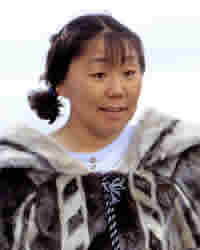Inuit in Canada

Photo Source:
Ansgar Walk - Wikimedia
Creative Commons
|
Send Joshua Project a map of this people group.
|
| People Name: | Inuit |
| Country: | Canada |
| 10/40 Window: | No |
| Population: | 47,000 |
| World Population: | 47,000 |
| Primary Language: | Inuinnaqtun |
| Primary Religion: | Christianity |
| Christian Adherents: | 55.00 % |
| Evangelicals: | 1.50 % |
| Scripture: | Portions |
| Ministry Resources: | Yes |
| Jesus Film: | No |
| Audio Recordings: | Yes |
| People Cluster: | North American Indigenous |
| Affinity Bloc: | North American Peoples |
| Progress Level: |
|
Introduction / History
The Inuit are an indigenous people who inhabit the icy northern regions of Canada. Scientists believed that their ancestors arrived at their present location by migration across the Bering Strait about 5,000 years ago (Pattara 2018). They have seen a lot of changes to their way of life, as early as the 11th century with Norse influence. From there, explorers, whalers, traders, missionaries, and scientists have changed the Inuit culture in many ways, from modern Inuit eating a more Western diet, to more individual conversions to Christianity. However, the Inuit still manage to keep their traditional cultural identity. Historically, they have also been called Eskimos.
Where Are they Located?
They are located in the northern regions of Canada (Freeman 2010). In 2011, almost 73% lived in a region of the Arctic called the Inuit Nunangat. Out of this percentage, half lived in Nunvaut, followed by Quebec, Labrador, and the Northwest Territories/Yukon.
What Are Their Lives Like?
Their language Inuktitut has five main dialects: Inuvialuktun, Inuinnaqtun, Inuktitut, Inuktitut, and Nunatsiavumiuttut. Their adobe is in igloos in winter and tents in summer. Transportation is accomplished through dog sledge; Inuit ancestors were the first to introduce the widespread use of dog sledding in the Americas (Ameen et al. 2019). The Inuit live as hunters and gatherers. They have large regional groupings that separate into winter camps, or bands, of around 100 and summer groups of fewer than a dozen. They hunt for walrus, moose, reindeer, beluga whale, polar bear, ptarmigans, and winter cod (Gadsby and Steele 2004). They eat the fish cooked, dried, smoked, or frozen. Summer pickings include blackberries and salmonberries. Some traditional Inuit dishes include muktuk and an ice cream called akutaq. They have a remarkable ability to refrain from showing anger (Doucleff and Greenhalgh 2019). Also, the elders do not yell or shout at their children. Such behavior is considered inappropriate in their culture. Instead, to discipline the kids they tell stories to keep them well behaved. For example, instead of telling a child to not go near the water, they will tell a story about monsters who will drag them down under the ocean.
What Are Their Beliefs?
A majority of the Inuit today are Christian, but they still have their traditional spirituality within the culture. In traditional spirituality, fear, rather than faith, drives their religious beliefs. They believe that no one rules the cosmos and their mythology is based on animism and shamanism. The animism aspect comes from their belief that all things have a spirit, that they call "anirniq." Once the spirit of a living being is liberated upon death, it can take revenge as much as it wants (Andrews 2017). The other part, shamanism, is still alive today. Some shamanists do their seances in greater secrecy than in the past due to outside culture influence and their own conversion to Christianity. Others feel like it should be preserved, saying that shamanism is part of a culture that includes respect for animals and sharing harvested food (bdbonta 2017). The Inuit also have a strong spiritual behavior with their food, giving thanks to the animal who gave up their life for their sustenance.
Prayer Points
Pray the JESUS Film will be made available in their language.